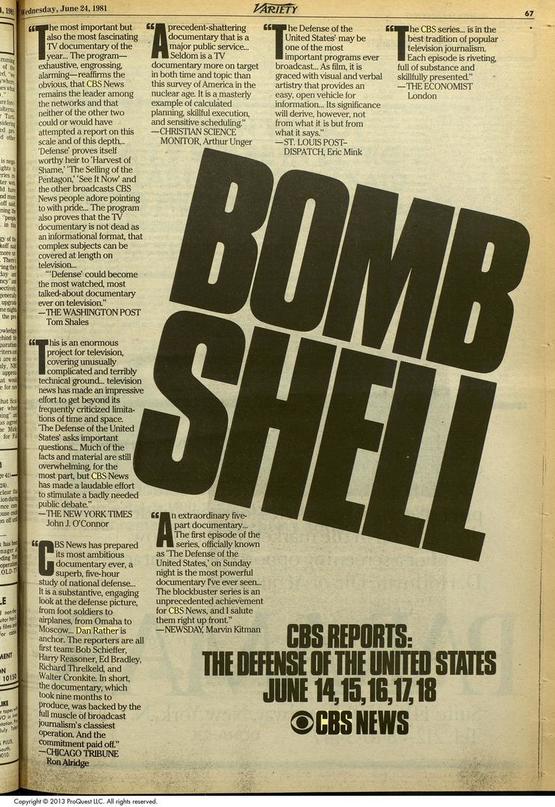Starting on June 14, 1981, CBS aired an ambitious, precedent-shattering five parts documentary on the U.S. defenses and the nuclear age. In an unprecedented scheduling arrangement, CBS News presented the five parts on consecutive evenings. The brainchild of CBS News president Bill Leonard, the documentary was produced by Howard Stringer (executive producer) and Andrew Lack (senior producer), and other seasoned producers such as Judy Crichton, Maurice Murad, and Craig Leake who worked for nine months on the project. Dan Rather anchored the entire series and he and his fellow correspondents Bob Schieffer, Harry Reasoner, Ed Bradley, Richard Threlkeld and Walter Cronkite reported from around the globe.
In the first part, entitled “Ground Zero,” Bob Scheiffer compares the Soviet and the U.S nuclear arsenal and examines the potential repercussions of a 15-megaton nuclear attack on the U.S, specifically the Strategic Air Command’s Ohama headquarters. Produced by Judy Crichton, “The Nuclear Battlefield,” looks at the buildup of tactical nuclear weapons along key borders. Harry Reasoner travels to Europe where he finds foot soldiers armed with nuclear weapons, trained to fight a conventional and a nuclear war at the same time.
In “Call to Arms,” the third installment produced by Maurice Murad, Ed Bradley looks into volunteer soldiers and the personnel problems the army is facing, from retention to finding skilled technicians. He investigates expensive “bureaucratic juggernaut,” caused by infights between military chiefs of the four services. President Dwight Eisenhower’s warming of a military-industrial complex is the topic of "The War Machine,” produced by Craig Leake. In this fourth section, Richard Threlkeld looks into money wasted on the wrong weapons, such as the F-18. Produced by Craig Leake, this segment analyses the ‘Iron Triangle” made of the Pentagon as consumer, the Congress as banker and the defense contractor as supplier. Andrew Lack produced the final installment, “The Russians,” in which Walter Cronkite travels to Moscow to learn more about Russians, the “enemy” and potential target of the U.S. weapons. They of course think of the America as the aggressor.
The documentary received rave reviews. Ron Aldrige in the Chicago Tribune called it CBS News' “most ambitious documentary ever, a superb five-hour study of national defense,” emphasizing that “it’s far from boring. It is a substantive, engaging look at the defense picture from foot soldiers to airplanes, from Ohama to Moscow.” He added that it was “a superb piece of journalism. It is thorough, informative, and balanced. It lays out the facts, puts them in perspective, and raises many questions.” Tom Shales in the Washington Post described it as “what may well be the first documentary epic in TV history, more notable for its quality than the size of its budget.” The program was proof that “documentary is not dead as informational format, that complex subjects can be covered at length on television.” Arthur Unger in the Christian Science Monitor deemed it "a major public service," and a "masterly example of calculated planning, skillful execution, and sensitive scheduling." Many reviewers pointed out that the report was timely as President Reagan announced he was planning on spending $1.3 trillion on defense, and just before the broadcast, Israeli completed s stunning raid on an Iraqi nuclear reactor. The American Security Council on the other hand was not as pleased, charging that the program lacked balance and was "filled with many false statements and misconceptions."


